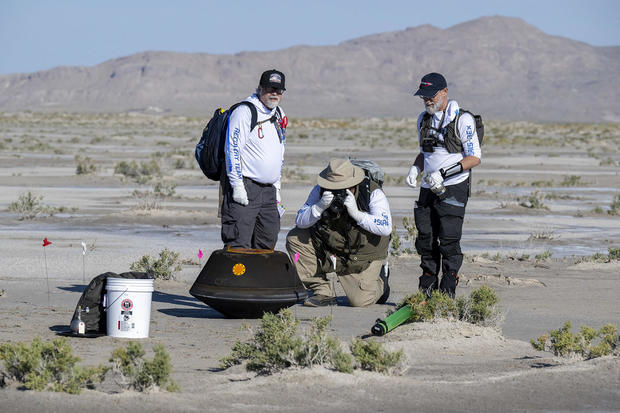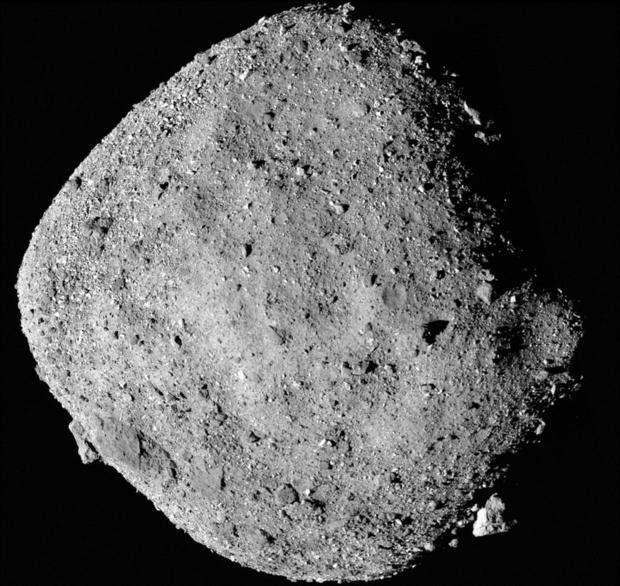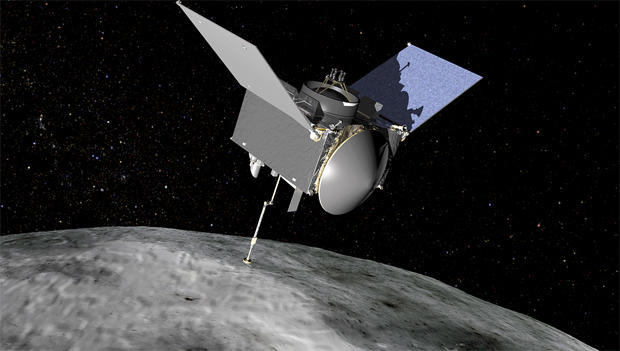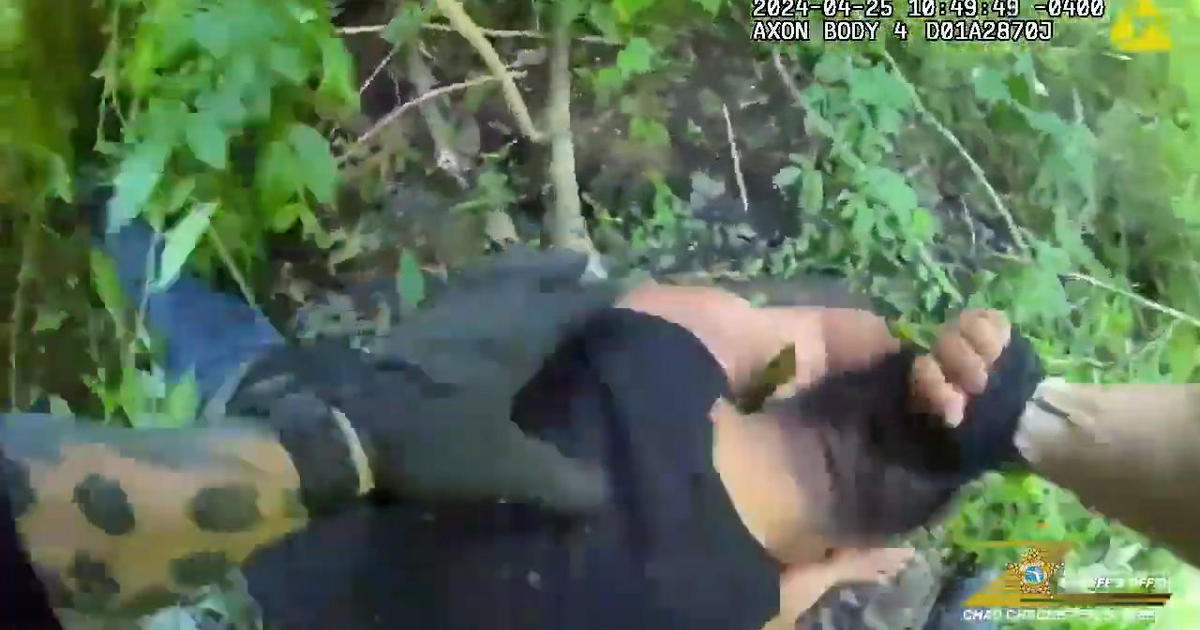NASA capsule brings home asteroid samples dating back to the birth of the solar system
A saucer-shaped capsule carrying asteroid fragments that may hold clues about the birth of the solar system slammed into Earth's atmosphere Sunday and descended to an on-target parachute-assisted touchdown in Utah to wrap up a dramatic seven-year, four-billion-mile voyage.
Released from the OSIRIS-REx mothership four hours earlier, the 110-pound 31-inch-wide sample return capsule, loaded with a half-pound of rocks and soil collected in 2020 from an asteroid known as Bennu, hit the top of the discernible atmosphere, 82 miles up, at a blistering 27,000 mph at 10:42 a.m. EDT.
Over the next two minutes, rapidly decelerating in a hellish blaze of atmospheric friction, the capsule's heat shield endured reentry temperatures of more than 5,000 degrees and a braking force 32 times the force of gravity as it streaked toward landing at the Utah Test and Training Range west of Salt Lake City.
With scientists and engineers holding their collective breath — a similar capsule crash landed in Utah in 2004 when its parachutes failed to open — the OSIRIS-REx sample return capsule survived its trial by fire and was expected to deploy a stabilizing drogue parachute at an altitude of 20 miles.
It's not yet clear when the drogue actually deployed or whether it inflated as planned. The capsule's 24-foot-wide main parachute unfurled at an altitude of 20,000 feet - 15,000 feet higher than expected. That may have contributed to a slightly earlier-than-expected touchdown, but in any case, the main chute worked flawlessly to lower the sample return capsule to a gentle 11-mph landing at 10:52 a.m. EDT, the final step in a nail-biting descent.
"I was getting a little worried, for sure," University of Arizona Principal Investigator Dante Lauretta, who's been working on the project for nearly 20 years, said at a post-landing news conference. "And then we heard main shoot detected, and I literally broke into tears. I'm probably gonna do it right now just thinking about it. Because that was the moment I knew we made it home.
"All of my energy and all my will has gone into making this thing a success. And I knew the moment the chute opened, that was it. From that point forward, there were no surprises left. And it was overwhelming, relief, gratitude, pride, awe, really trying to convince myself that I wasn't dreaming ... that the chute was open that the capsule was coming down and we got that science treasure in hand."
Recovery crews from prime contractor Lockheed Martin and the Utah Test and Training Range were on the scene within minutes to document the condition of the capsule, looking for any signs of a breach that could cause contamination of the pristine samples inside.
Lauretta was on site as well, part of a team assigned to characterize the surrounding environment to thoroughly document the chemical makeup of the landing zone. Just in case.
But there were no apparent problems, the capsule was intact and there were no signs of any breaches that could have let earthly contaminants inside. Once that was confirmed, a helicopter carried the capsule to a temporary air-filtered "clean room" to begin disassembly and to make preparations to ship the samples to a more sophisticated laboratory at the Johnson Space Center in Houston on Monday.
"Today capped the end of an almost 20-year adventure for me," Lauretta said. "It was pulse pounding, waiting for that main chute to come out, right? ... And it worked, and it worked spectacularly well. Boy, did we stick that landing!"
The samples — the largest collection of extraterrestrial material returned to Earth by a U.S. spacecraft since the Apollo moon program — are representative of the raw material that formed the sun and its retinue of planets 4.5 billion years ago.
"We're going back to the dawn of the solar system, we're looking for clues as to why Earth is a habitable world, this rare jewel in outer space that has oceans, it has a protective atmosphere," Lauretta said earlier. "We think all of those materials were brought (to Earth) by these carbon-rich asteroids very early in our planetary system formation.
"And of course, the biggest question, the one that drives my scientific investigations, is the origin of life. What is life? How did it originate? And why was the Earth the place that it occurred? ... We believe that we're bringing back that kind of material, maybe representatives of the seeds of life that these asteroids delivered at the beginning of [Earth's history]."
Two Japanese spacecraft returned small samples from asteroids in 2010 and 2020, but OSIRIS-REx — a convoluted acronym that stands for Origins, Spectral Interpretation, Resource Identification and Security Regolith Explorer — is the first such mission mounted by NASA.
After initial analysis in Houston, NASA will share samples of Bennu with researchers around the world.
"This is a gift to the world," Lauretta said. "We have laboratories on four continents, 16 timezones, hundreds of researchers, over 60 laboratories that have been getting ready to get this material, and we are ready to begin the final science campaign of the OSIRIS-REx prime mission."
Equipped with three cameras, two spectrometers, a laser altimeter and an X-ray imaging system developed by college students, the OSIRIS-REx spacecraft and sample return capsule were launched atop a United Launch Alliance Atlas 5 rocket from Cape Canaveral on Sept. 8, 2016.
To reach Bennu, which orbits in a plane tilted six degrees from Earth's, OSIRIS-REx looped around the sun and then made a velocity-boosting gravity-assist flyby of Earth on Sept. 22, 2017. The spacecraft finally slipped into orbit around Bennu in late 2018.
Scientists were stunned at what they found. Instead of a more typical body, with fine-grained soils and rocks atop a more or less solid interior, Bennu, about as wide as the Empire State Building is tall, turned out to be a loosely compacted rubble pile that behaved more like a fluid than a solid.
After extensive mapping to identify a safe sample-collection point, OSIRIS-REx slowly descended toward the surface on Oct. 20, 2020, its pie pan-shaped "Touch-And-Go Sample Acquisition Mechanism," or TAGSAM, poised at the end of an 11-foot-long robot arm.
On contact, the probe fired a jet of nitrogen gas around the interior of the 12-inch-wide TAGSAM, stirring up the soil and small rocks underneath and blowing some of the material into collection filters before the spacecraft reversed course and backed away.
"It behaved very much like a fluid, there was no resistance to the downward motion of the spacecraft," Lauretta said in an interview. "We sank in about 50 centimeters (20 inches) and if we hadn't fired the back-away thrusters, I think we would have just gone right into the asteroid and disappeared."
After backing away from Bennu, the TAGSAM mechanism and its precious samples were stowed inside the OSIRIS-REx return capsule for the long flight back to Earth and Sunday's dramatic reentry.
After course corrections to line up on the Utah landing site, the OSIRIS-REx mothership released the sample return capsule at 6:42 a.m. EDT. With the capsule safely on its way, the OSIRIS-REx spacecraft fired its thrusters 20 minutes later, ensuring it would safely miss Earth by about 484 miles.
The "divert" maneuver put the craft on course for a close encounter with the asteroid Apophis in 2029.
Roughly 1,200 feet across, Apophis will come within a scant 20,000 miles of Earth in 2029, a very near miss in astronomical terms. The OSIRIS-REx spacecraft, now known as the OSIRIS-Apophis Explorer, will brake into orbit around Apophis shortly after the asteroid's Earth flyby, kicking off extended observations.










